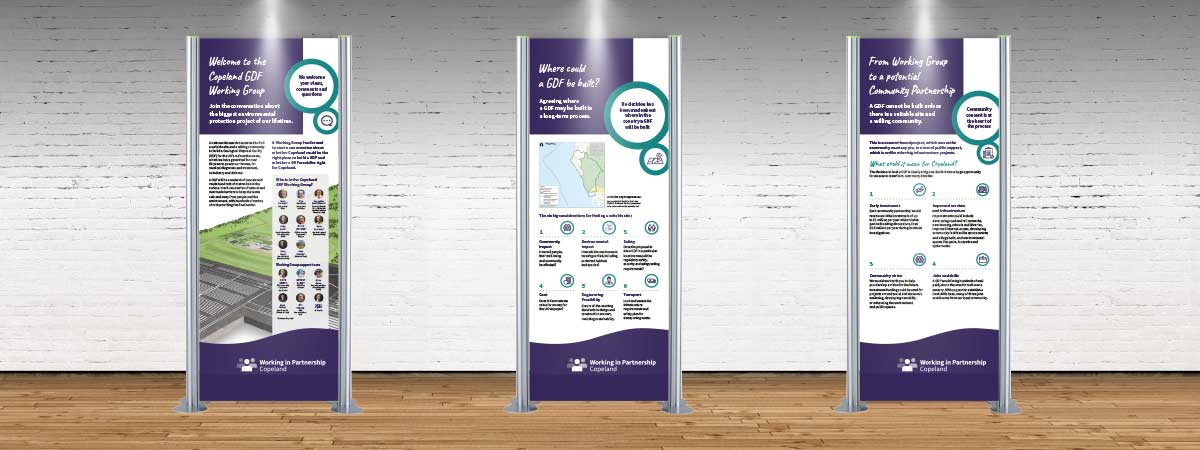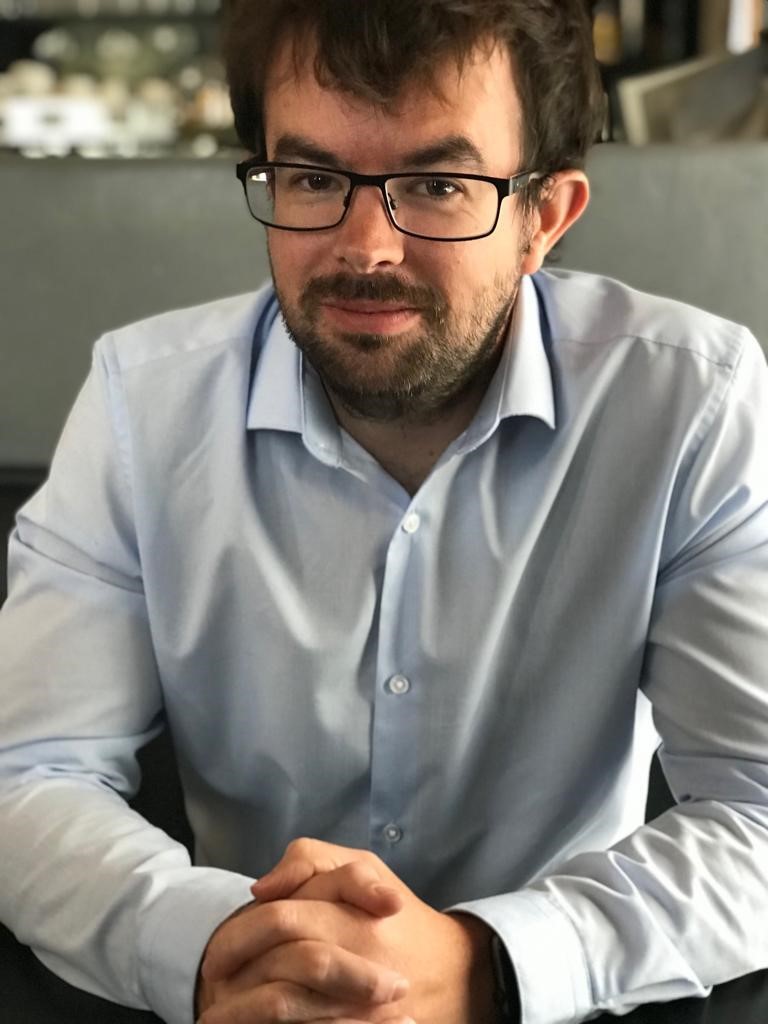
Welcome to the July edition of the Copeland GDF Working Group newsletter.
Our main focus for this month is a series of pop-up events we are holding across Copeland during July and August, as well as work on how we’re preparing for the potential Community Partnership part of the GDF process. We also have a piece on ‘What will a Geological Disposal Facility look like?’ and a guest blog from Luke Richardson, Head of Social Impact for Programme and Project Partners (PPP) – a partnership transforming project delivery at Sellafield.
The Working Group’s community engagement team has organised a number of drop-in events in locations across Copeland to meet with people face to face. The events will be limited to a small number of people at any one time, following Government Covid guidance, so take a look at the list further on in the newsletter and drop-in to see us.
One of the tasks of the Copeland GDF Working Group is to help begin to understand community issues, examine any concerns and questions the public has about a GDF and begin conversations about what it could mean for Copeland.
Up until now, most of those conversations have had to take place virtually – which has been a really valuable way of having discussions with people and hearing their views. However, seeing people in person and continuing those conversations is something the Working Group is really looking forward to and this will be our first chance to do that.
We also have some larger events being prepared for September. The plans we had provisionally for summer for a larger exhibition roadshow will still go ahead, in line with Government guidance, now scheduled for September 1-17. Further details and venues on that to follow at a later date – but do pencil it into your diary.
Some of our current activity includes preparing for the potential Community Partnership part of the GDF process in Copeland. If the Working Group progresses to this point – which would involve more members of the community who would look at the GDF possibilities for Copeland in more detail – then some of that initial preparatory work is needed now.
A Partnership would take over from the Working Group – interim at first until it gets going and there are more members – to continue discussions with local people, identify priorities for Community Investment Funding, agree activities to further people’s understanding of GDF and potential implications, as well as develop a community vision.
All of that, of course, will be for any Partnership to decide, but we are helping with that now by looking at what support a Partnership would require; helping to develop an appointment process for identifying a Chair and members; drafting a potential Community Partnership Agreement and thinking about what skills, knowledge and experiences Community Partnership members may require.
If a Community Partnership forms then this would make available Community Investment Funding to the partnership – up to £1million per year, rising to £2.5million a year if deep borehole investigations take place to assess geology.
Funding would be available to promote community wellbeing, such as new community facilities; economic development such as jobs and skills support and enhance the local environment.
A Community Investment Panel, which would be made up of members of the Community Partnership and/or co-opted members, would be set up to help manage the funding and make decisions allowing communities to determine their own priorities for the investment. Work on helping to lay the groundwork for this is also ongoing.
In the meantime, continue to get in touch with us. The Working Group welcomes any requests for information or talks, views can be shared and questions can be asked in a variety of ways here.
Our website is also a really good tool – you’ll find everything from what a GDF is, why it’s needed and our latest news, to how you can get involved and some Frequently Asked Questions.
You can also visit our Virtual Exhibition – an interactive digital experience to find out more information about geological disposal and what it could mean for Copeland.
 Mark Cullinan
Mark Cullinan
Independent Chair
Copeland GDF Working Group
Pop-up events in Copeland on geological disposal

Gillian Johnston Community Engagement Manager, Copeland GDF Working Group
Copeland GDF Working Group is holding a series of pop-up events over the next few weeks to continue the conversation about geological disposal.
A Geological Disposal Facility (GDF) is an underground facility designed to safely and securely dispose of higher activity radioactive waste.
Members of the community are invited to drop-in and have a chat with the local community engagement team, pick up a leaflet, ask a question or share views. The informal events will take place in different areas of Copeland – limited to small numbers to ensure Covid-safety and will operate within Government guidance.
These events will be followed by a larger exhibition roadshow which the Working Group plans to run during September.
Gillian Johnston, Copeland Working Group’s Community Engagement Manager, said:
“We’re looking forward to being able to speak face to face with people about what geological disposal could mean for Copeland. The Working Group is here to help inform people about GDF, listen to views and answer any questions people may have. Come along and have a chat with the local team.”
The drop-ins are being held in the following locations:
- July 22 Cleator Moor Town Council offices, Market Square, 10am-3pm
- July 28 Thwaites Village Hall, 10am-3pm
- July 30 Cumbria Traders’ Day Market, St Nicholas’ Gardens, Whitehaven, 9.30-3pm
- Aug 5 Egremont Meeting Place, Methodist Church, 10am-3pm
- Aug 11 Seascale Library, 10am-3pm
- Aug 20 Millom Conservative & Unionist Club, Lapstone Road, 10am-3pm
 As part of the process to find a site for a GDF in England or Wales, a Working Group was formed in Copeland last November. It has three main tasks – begin to understand community issues, examine any concerns and questions the public has about a GDF; identify a search area or areas within Copeland and recruit initial members for a Community Partnership which could take that work forward.
As part of the process to find a site for a GDF in England or Wales, a Working Group was formed in Copeland last November. It has three main tasks – begin to understand community issues, examine any concerns and questions the public has about a GDF; identify a search area or areas within Copeland and recruit initial members for a Community Partnership which could take that work forward.
Construction of a GDF facility is based on consent – which means there must be a suitable site and a willing community in order to proceed.
The larger exhibitions are set to take place from September 1-17th around Copeland and will feature information boards, interactive activities and experts in different subjects to help answer questions.
What will a GDF look like?

Illustrative aerial view of a GDF surface-layout
A Geological Disposal Facility (GDF) is designed to safely and securely dispose of higher activity radioactive waste. It has both surface and underground secure facilities linked by sloping tunnels or shafts – but which is mostly deep underground.
The underground disposal areas do not need to be located directly below the surface site – they could be separated by several kilometres. This means a surface facility on the coast could provide access to a disposal area deep in the rock beneath the seabed.
A GDF and its surface facilities will be a nuclear licenced site. The surface facilities will cover about 1 square kilometre and would look like a secure industrial complex, with a variety of security measures, and which would connect to the local transport network to support its construction and operation. The details on the layout and appearance of the surface facilities are dependent on the features of a particular location.
Iain Phimister, Radioactive Waste Management’s Principal Engineering Integrator, said: “We will work with local communities to develop the design and layout of GDF surface facilities to ensure they are sympathetic to the local environment.
“Throughout the process, we will look at ways to ensure that the impact of the project on the local environment is minimised and explore opportunities for environmental improvement. Our aim is to achieve a net environmental benefit.”
The surface facilities of a GDF will receive different types of radioactive waste packages from across England and Wales and make them ready for their journey underground. It is envisaged that most waste packages will arrive at a GDF site by rail, with some arriving by road. Waste packages could also arrive by sea, depending on the location.
The packages will be unloaded from their transport vehicle and loaded onto specially designed vehicles for transfer underground. When lot of packages arrive at once (e.g. on a train), then some will be stored on the surface for a short period.
There will be various other facilities on the surface, including offices, control rooms, workshops, laboratories, railway sidings, roads and car parks. There will also be areas for storing excavation equipment and construction materials, as well as for storing excavated rock. Later on, once the waste has been placed underground, some of this rock may be used for backfilling the excavated areas and closing the GDF. The rest will be landscaped or transported off-site.
There would be a staged approach to building vaults and tunnels as well as the placing and disposing of radioactive waste packages. The packaged solid waste that goes into a GDF will be placed in a series of vaults and tunnels between 200 metres and about 1,000 metres below the surface.
Iain added: “The waste packages will be securely held in the engineered barriers and the stable rock formation, where the waste will naturally lose its radioactivity over time. The underground facility could cover between 10 to 20 square kilometres depending on the location and final waste inventory.
“We will operate a GDF for at least 100 years. It will be built in stages with each vault built and filled as and when it is needed. On completion, the vaults and tunnels will be closed and sealed. It would then take another ten years to fully close the GDF and remove the surface facilities.”
To find out more – watch this short video.
 We asked Luke Richardson, Head of Social Impact at Programme and Project Partners (PPP), to share his thoughts around geological disposal and what it could mean for Copeland. PPP was formed in 2019 – bringing in KBR, Doosan Babcock, Jacobs and Morgan Sindall Infrastructure – to transform major project delivery at Sellafield.
We asked Luke Richardson, Head of Social Impact at Programme and Project Partners (PPP), to share his thoughts around geological disposal and what it could mean for Copeland. PPP was formed in 2019 – bringing in KBR, Doosan Babcock, Jacobs and Morgan Sindall Infrastructure – to transform major project delivery at Sellafield.
“First and foremost, I would like to thank the Copeland Working Group for inviting me to share my views on this very important process.
I want to focus on two important parts:
- The importance of engaging in the process of the Copeland Working Group
- The community investment which will be triggered by a Community Partnership being formed.
The work that is under way to find a suitable site and willing host community is of significant national and local importance and, quite rightly, is attracting substantial interest and opinion.
Nationally, the outcome is finding the right place (and community) for a Geological Disposal Facility (GDF). Locally, it’s about whether that location is Copeland. Before we decide, we will see community investment if a Community Partnership is formed. That is a fantastic opportunity and so welcome in these times.
The second is about the economic and social benefit the site could bring to Copeland if we opt to welcome it. But let us be clear, where a GDF ends up is a question that will not be answered now.
The process of finding a suitable site for a GDF could take up to 15 years. During the process of finding the site, Community Partnerships will be formed. These Community Partnerships will trigger millions of pounds of community investment funding into those areas.
Copeland has a significant role to play in this process, regardless of the final location of a GDF in England or Wales. The majority of the waste that will be disposed of in a GDF is coming from or via Sellafield.
So, I leave you with these recommendations:
First, engage with the process via the Copeland Working Group.
Second, get involved in the engagement sessions run by the Copeland Working Group. Engage your family and friends as well.
Third, let your voice be heard. You are a part of the community. It’s only fair that everyone has the chance to share their views.
And fourth, welcome the opportunity of investment that comes with a Community Partnership. More so now than ever, we need to welcome investment in our local communities.”
Open to question: Some useful questions with answers from Radioactive Waste Management (RWM)
How much of the radioactive waste planned for disposal in a GDF is from old or existing facilities?
About 90% of the packaged volume of waste planned for disposal in a GDF comes from past or existing facilities. Some of this waste already exists and more will arise in the future as existing nuclear facilities reach the end of their operating life and are decommissioned.
How much radioactive waste will go into a GDF?
We are currently planning on the basis of around 750,000 cubic metres of packaged waste in total. This includes materials that may be designated as waste in future, including all of the waste from a potential 16GWe of future new nuclear power. To provide an idea of scale, this would fill about two thirds of Wembley Stadium.
How long will the waste be hazardous?
Whilst 99% of the radioactivity will decay naturally in about 1,000 years, some of the radioactive waste will remain hazardous for over 100,000 years. The multi-barriers of the GDF will isolate and contain radioactive waste away from the surface environment until the levels of radioactivity decrease to non-harmful levels.

